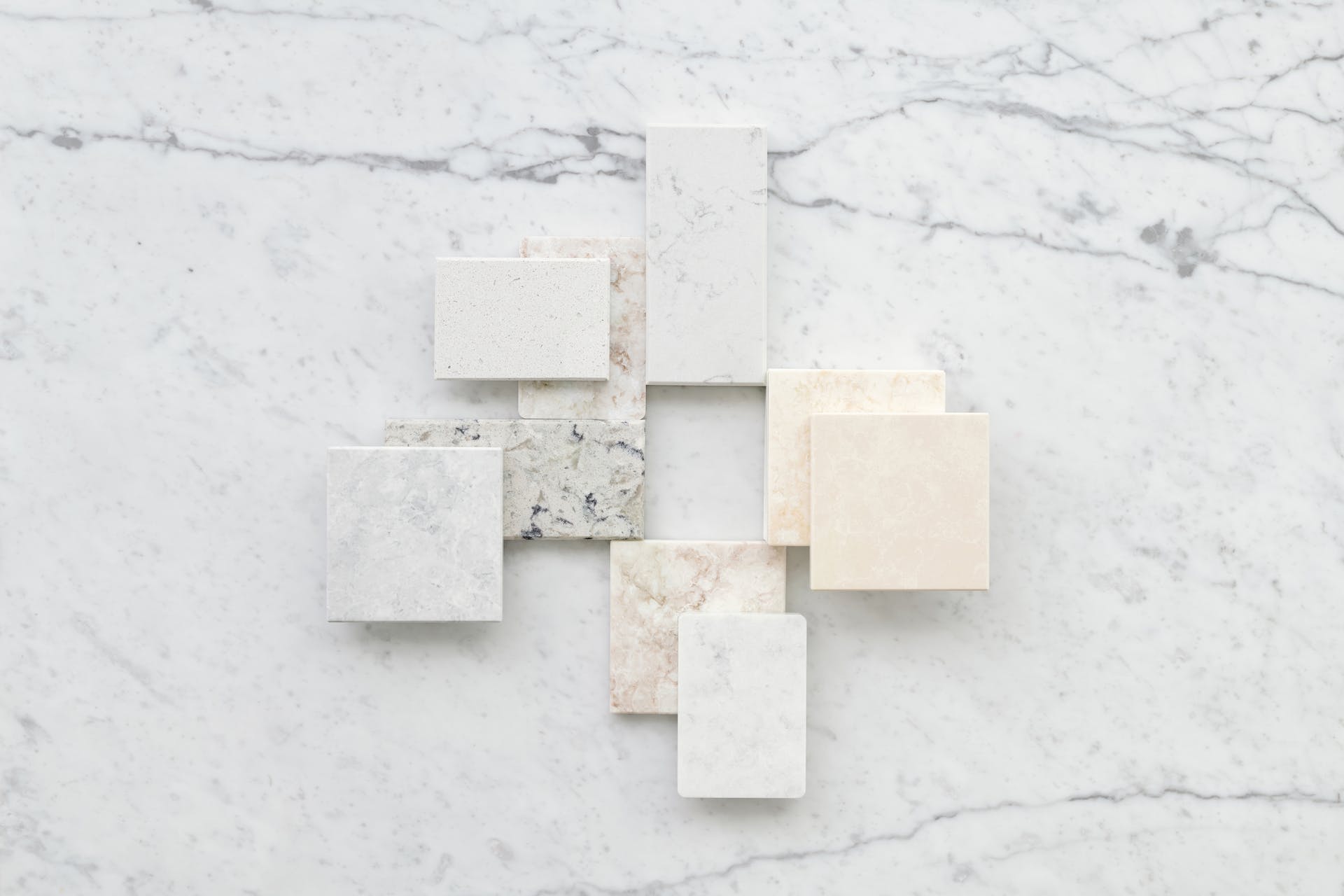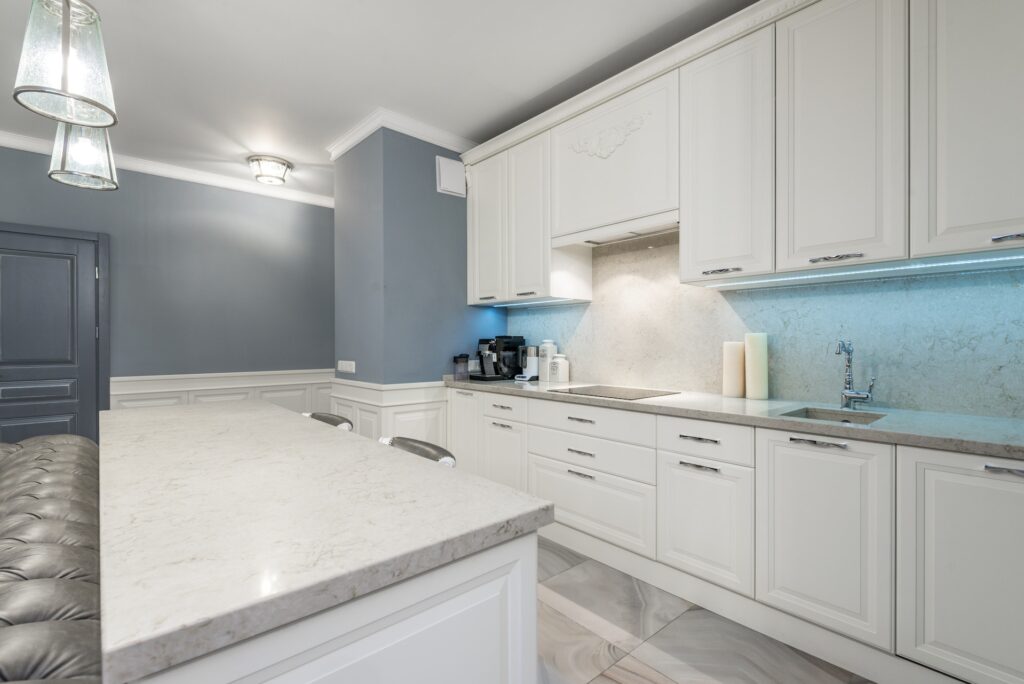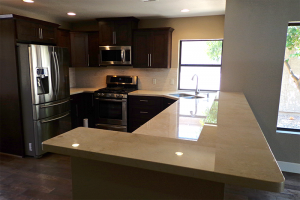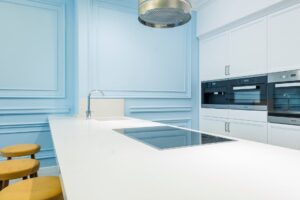Marble, a timeless and luxurious stone, has been a symbol of opulence and refinement for centuries. Its natural elegance and unique veining patterns make it a favorite choice for countertops, floors, and other architectural elements. While polished marble is the most common finish, honed marble has been gaining popularity in recent years. In this extensive article, we will delve deep into the world of honed marble, exploring what it is, its characteristics, applications, care, and the reasons behind its growing popularity.
- What Is Honed Marble?
- Honing Marble
-
Advantages of Using Honed Marble: A Subdued Elegance
- 1. Timeless Elegance:
- 2. Enhanced Color and Veining:
- 3. Durability:
- 4. Anti-Slip Properties:
- 5. Versatility:
- 6. Conceals Imperfections:
- 7. Warm and Cozy Atmosphere:
- 8. Aesthetic Flexibility:
- 9. Ageless Beauty:
- 10. Ease of Maintenance:
- 11. Versatile Applications:
- Applications of Honed Marble
- The Appeal of Honed Marble
- Care and Maintenance
- Conclusion
Marble is a remarkable natural stone known for its timeless beauty and classic appeal. Whether used in countertops, floors, or various architectural elements, marble adds a touch of elegance to any space. While polished marble is the most common finish, honed marble offers a unique and more subdued appearance that has been gaining popularity in recent years. If you’re considering honing marble to enhance its natural beauty, this extensive guide will walk you through the process step by step.
Honed marble is a captivating and distinctive variety of this time-honored natural stone, celebrated for its subdued elegance and unique visual appeal. In contrast to the traditional polished marble, honed marble undergoes a specific finishing process that imparts a matte or satin-like surface, which not only exudes sophistication but also enhances the stone’s natural characteristics.
What Is Honed Marble?
Honed marble is a type of marble that has undergone a specific finishing process, resulting in a matte or satin-like surface. Unlike polished marble, which has a high-gloss and reflective finish, honed marble has a smooth, non-reflective appearance. It is achieved by grinding the marble’s surface to a consistent level, removing any imperfections, and creating a flat, even texture.
Characteristics
Honed marble possesses distinct characteristics that set it apart from other finishes:
- Matte Appearance: The most noticeable characteristic of honed marble is its matte, non-reflective surface. It lacks the polished marble’s shiny, mirror-like finish, offering a more understated and subdued appearance.
- Smooth Texture: Honed marble is smooth to the touch but doesn’t have the slippery feel of polished marble. Its texture is more velvety and inviting.
- Enhanced Color and Veining: The honing process often brings out the natural color and veining of the marble, making it more vivid and prominent.
- Conceals Imperfections: Honed marble can hide minor flaws and etchings better than polished marble, making it a preferred choice for high-traffic areas.
The Growing Popularity of Honed Marble
Honed marble has seen a resurgence in popularity in recent years for various reasons:
-
Modern Aesthetics
In contemporary interior design, the emphasis on minimalism and subdued elegance aligns perfectly with the matte finish of honed marble. Its unpretentious appearance complements clean lines and sleek, modern spaces.
-
Unique Character
The honing process often enhances the natural color and veining of the marble. This uniqueness appeals to homeowners and designers seeking individuality in their spaces.
-
Practicality
The ability of honed marble to conceal minor imperfections and resist slipping makes it a practical choice for high-traffic zones like kitchens and bathrooms.
-
Versatility
Honed marble’s compatibility with various design styles and its adaptability for different applications make it a versatile material that appeals to a broad spectrum of tastes and preferences.
Honing Marble
Tools and Materials
Before you begin the honing process, gather the necessary tools and materials:
- Honing Machine: A machine equipped with diamond abrasive pads is essential for grinding the marble surface.
- Diamond Abrasive Pads: These pads come in various grit levels and are used to grind and refine the marble surface.
- Safety Gear: Safety glasses, gloves, and a dust mask are crucial to protect yourself during the process.
- Wet-Dry Vacuum: You’ll need a vacuum to clean up the dust and debris created during the honing process.
- Stone Sealer: After honing the marble, you’ll need a quality stone sealer to protect and enhance the stone’s appearance.
- pH-Neutral Stone Cleaner: To clean the marble before sealing and for regular maintenance.
- Soft Cloths or Sponges: These are used for cleaning and applying the stone sealer.
- Container with Water: For rinsing and cleaning the marble surface.
The Honing Process
Now, let’s dive into the steps to hone marble:
1. Preparation
- Clear the Area: Ensure the workspace is clear of any obstacles and that the marble surface is clean of debris and dust.
- Safety Gear: Put on your safety glasses, gloves, and a dust mask to protect yourself from dust and debris generated during the honing process.
2. Grinding
- Select the Grit Level: Start with a lower grit diamond abrasive pad (around 50-100 grit) to remove the existing polished finish and any imperfections.
- Operate the Honing Machine: Follow the manufacturer’s instructions for operating the honing machine. Begin grinding the marble surface in a back-and-forth, overlapping pattern. Keep the machine moving steadily.
- Change the Pads: As you progress, switch to higher-grit diamond abrasive pads (e.g., 200-400 grit) to refine the surface further.
- Rinse and Clean: Periodically stop to rinse the marble surface with water and use a wet-dry vacuum to tidy up the dust and slurry.
- Inspect the Surface: After using the higher grit pads, inspect the marble surface to ensure that you have achieved the desired level of honing. If necessary, continue honing with even higher grit pads for a smoother finish.
3. Cleaning
- Thoroughly Clean the Surface: Use a pH-neutral stone cleaner to remove any residue or debris from the honing process. Rinse with clean water and dry the surface thoroughly with a soft cloth or sponge.
- Apply Stone Sealer: To protect and enhance the marble, apply a quality stone sealer following the manufacturer’s instructions. Allow it to dry for the recommended time.
- Final Clean-Up: Once the sealer has dried, give the marble a final clean to ensure a polished and honed surface that’s free of streaks.
Advantages of Using Honed Marble: A Subdued Elegance
Honed marble, with its matte, non-reflective finish, offers several advantages that make it an enticing choice for interior design. Whether used for countertops, flooring, wall cladding, or other architectural elements, honed marble can enhance a space’s aesthetic and practical aspects. Here are the key advantages of using honed marble:
1. Timeless Elegance:
Honed marble exudes timeless and understated elegance. Its matte finish is less flashy than polished marble, making it a versatile choice for various design styles, from traditional to modern. It provides a sophisticated and classic look that transcends passing design trends.
2. Enhanced Color and Veining:
The honing process often brings out the natural colors and veining of the marble more vividly than a polished finish. The added depth and character contribute to the stone’s unique and captivating appeal, making each piece distinct.
3. Durability:
Honed marble is a durable and long-lasting material, making it suitable for high-traffic areas in both residential and commercial spaces. While it may show wear over time, its matte finish can gracefully age, revealing character and charm.
4. Anti-Slip Properties:
Honed marble offers a secure, non-slip surface, making it an ideal choice for areas where safety is a concern, such as entryways, bathrooms, and kitchen floors. Its smooth yet non-reflective texture provides a visually appealing and secure solution.
5. Versatility:
Honed marble pairs seamlessly with a variety of materials, allowing for diverse design choices. It can be incorporated into an extensive range of design styles, from minimalist and contemporary to opulent and classic, offering creative possibilities to designers and homeowners.
6. Conceals Imperfections:
Honed marble is more forgiving when it comes to concealing minor imperfections and etchings, making it an excellent choice for high-traffic areas. This feature can reduce maintenance efforts and maintain the stone’s appearance.
7. Warm and Cozy Atmosphere:
The matte finish of honed marble adds to the warmth and coziness of the space, particularly when used for elements like fireplace surrounds and mantels. It creates a welcoming ambiance that enhances the comfort of a room.
8. Aesthetic Flexibility:
Honed marble is highly adaptable, allowing for versatile design choices. It harmonizes beautifully with a wide range of materials, enabling creative combinations in interior design projects.
9. Ageless Beauty:
Over time, honed marble may develop a patina that adds to its charm and character. This natural aging process can be seen as a feature rather than a flaw, giving the stone a unique and enduring beauty.
10. Ease of Maintenance:
While honed marble requires proper care and maintenance, its matte finish is more forgiving when it comes to hiding minor flaws and etchings, reducing the need for frequent polishing and upkeep.
11. Versatile Applications:
Honed marble can be used in various applications, including countertops, flooring, wall cladding, fireplaces, and furniture. Its adaptability and aesthetic appeal make it suitable for a wide range of design concepts.
In summary, the advantages of using honed marble lie in its ability to provide a timeless, elegant, and versatile aesthetic while offering practical benefits such as durability, anti-slip properties, and ease of maintenance. Its subdued charm and enhanced color and veining make it a favored choice for interior designers and homeowners seeking a sophisticated and enduring material for their spaces.
Applications of Honed Marble
-
Countertops
Honed marble countertops have become increasingly popular in kitchens and bathrooms. Their matte finish provides an elegant and timeless look that complements various design styles, from classic to contemporary. They are particularly suitable for homeowners who appreciate the beauty of natural stone but prefer a subtler appearance over the high sheen of polished marble.
-
Flooring
Honed marble is an excellent choice for flooring, especially in areas that demand slip resistance. Its smooth yet non-reflective surface offers a visually appealing and safe solution for spaces such as entryways, living rooms, and hallways.
-
Wall Cladding
Honed marble’s matte finish is ideal for wall cladding, adding a touch of sophistication to interior and exterior spaces. Whether used in residential or commercial settings, it lends a sense of timeless elegance.
-
Fireplaces
Honed marble is a popular choice for fireplace surrounds and mantels. It enhances the visual appeal of the fireplace, giving it a refined and classic look. The matte finish adds to the cozy atmosphere a fireplace can create.
-
Furniture
Incorporating honed marble into furniture pieces, such as coffee tables, side tables, and credenzas, can elevate the aesthetics of a room. Its smooth texture and subdued sheen make it a versatile material for various design concepts.
The Appeal of Honed Marble
-
Timeless Elegance
Honed marble exudes a timeless and classic elegance that fits well within a wide range of design aesthetics. Its understated appearance can complement both traditional and contemporary interiors, providing a versatile option for architects and designers.
-
Enhanced Color and Veining
The honing process often brings out the natural color and veining of the marble more vividly than a polished finish. It can add a sense of depth and character to the stone, making each piece unique.
-
Durability and Low Maintenance
Honed marble is more forgiving when it comes to concealing etches and minor imperfections. This quality, coupled with its durability, makes it an excellent solution for high-traffic areas in homes and commercial spaces.
-
Anti-Slip Properties
In applications where safety is a concern, such as flooring in entryways or bathrooms, honed marble provides a secure, non-slip surface without sacrificing aesthetics.
-
Aesthetic Flexibility
The matte finish of honed marble pairs well with other materials, allowing for diverse design choices. It can be incorporated into a huge array of design styles, from minimalist to opulent.
Care and Maintenance
While honed marble has several advantages, it is essential to understand its care and maintenance requirements:
1. Sealant
Honed marble is more pervious than polished marble, which means it is more susceptible to staining. It is advisable to apply a high-quality stone sealer to protect the stone. This sealer should be reapplied periodically to maintain its effectiveness. Periodical reapplication of the stone sealer can also protect the marble from stains and enhance its appearance.
2. Cleaning
Regular cleaning with a pH-neutral stone cleaner is recommended. Avoid using acidic or harsh cleaners, as they can damage the marble’s finish. It’s essential to clean up spills promptly to prevent staining as it is more porous than polished marble. Regularly clean the surface with a pH-neutral stone cleaner and a soft cloth or sponge to remove dirt and maintain the matte finish.
3. Prevention
To lessen the risk of damage, use coasters, trivets, and placemats under items that may scratch or stain the marble surface. Be cautious with acidic substances like citrus fruits, vinegar, and wine, as they can etch the stone.
4. Protection
Honed marble can be more vulnerable to scratches than polished marble. Therefore, protecting it from abrasive materials and sharp objects is a good practice. Use coasters and trivets under items that may scratch or stain the marble.
Conclusion
Honed marble is a captivating and versatile stone finish that has reemerged as a preferred choice for interior and exterior design. Its matte appearance, enhanced color and veining, durability, and versatility make it an appealing option for a wide range of uses, from countertops and flooring to wall cladding and furniture. With the right care and maintenance, honed marble can provide a lifetime of enduring beauty and elegance in any setting, making it a timeless choice in the world of interior design.
Honed marble, with its matte, velvety finish, is an embodiment of timeless elegance and versatile beauty. Its ability to showcase the natural color and veining of the stone, combined with its durability and aesthetic flexibility, makes it an exquisite choice for various design applications. With the right care, honed marble is an enduring investment that will stand the test of time, captivating all who encounter its understated charm and timeless allure.











